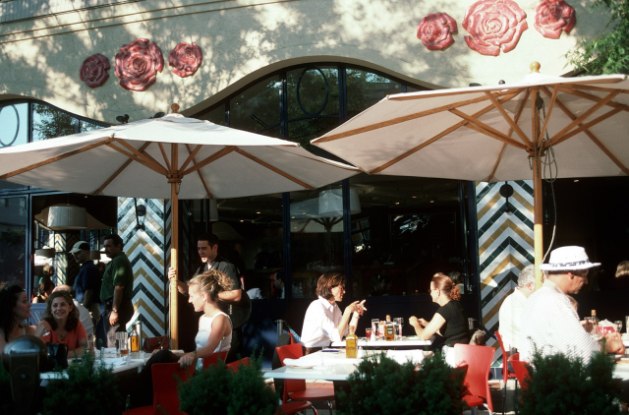
2002 photo by Chris Spielmann.
Previously published at WGBHNews.org.
We wedged ourselves between the concrete Jersey barriers that were separating the parking lot from the outdoor dining area and approached a server. “Would you like a table inside or out?” she asked. “Out!” we replied with some alacrity.
It was a beautiful recent evening — the third time we had ventured to restaurants since the COVID-19 restrictions had eased. There was no way we were going to eat inside; frankly, we would have been reluctant to use the restrooms if nature had called.
But eating out provided us with a blessed sense of normality that had been missing in those locked-down days of spring. It helped that the restaurants we visited were all doing it right — masked servers, tables spread apart, customers and staff friendly and chill. We’ve also had friends over a few times, outdoors, socially distanced, masked up when getting food or drinks. It was almost enough to make you think that life as we knew it was gradually beginning to return.
Now it’s starting to look like a fantasy — a lull before the next wave of pandemic restrictions rather than a sign of real progress.
We all know what’s going on. Nationally, the situation has been disastrous for many weeks, as the number of cases and the death toll have been rising in southern and western states that had been largely unaffected by the early wave. Over the weekend, Dr. Deborah Birx, who is overseeing the Trump administration’s response to the pandemic, called the current surge “extraordinarily widespread.”
In Massachusetts, where our early, terrifying outbreak had been brought under control, the numbers are creeping back up. “What we’re seeing are the indicators that a surge is coming,” Northeastern University epidemiologist Samuel Scarpino told The Boston Globe earlier this week.
Scarpino is urging Gov. Charlie Baker and other officials to reimpose some of the restrictions that had been in place earlier in the pandemic. At the same time, thousands of college students are about to descend upon the area, many of them from states like Florida and Texas, where mask-wearing is seen as something that only socialists do.
It’s now clear that plans made during May and June, when some green shoots of optimism began sprouting from the barren soil, are no longer realistic. The return of Major League Baseball has been a five-alarm disaster. Office workers are being told to stay home until January at the earliest. Hopes of reopening public schools this fall, either fully or in part, have given way to demands from the teachers unions that classrooms remain closed until safety concerns can be addressed. Colleges and universities — including Northeastern, where I teach — are for the moment sticking with plans they made months ago to reopen for at least some in-person classes, but that’s looking increasingly unlikely.
What’s also been clear for some time now is that President Donald Trump’s abdication of leadership transformed a situation that would have been bad in any case into something infinitely worse. “Despite ample warning, the U.S. squandered every possible opportunity to control the coronavirus,” writes Ed Yong of The Atlantic near the top of his massively researched overview of the Trump administration’s failures.
So now what? The economy is sliding backwards, and real suffering is on the horizon if Congress fails to pass another relief bill — or, frankly, if it passes the Republican version, which is grossly inadequate.
And the respite we’ve been enjoying in recent weeks will begin to fade. Soon we may no longer have the option of going to restaurants and sitting inside — it’s either the parking lot or nothing. There will be rainy days. And it will start to get cold. And more and more restaurants, struggling to hang on since March, will shut down.
Public schools will struggle once again with Zoom classes as parents try to balance their kids’ education with their own need to work. Higher education may have to return to online-only, and hard-pressed families will start to demand answers to why they’re paying massive tuition bills for a University of Phoenix-style experience.
And those lazy evenings of al fresco dining will start to look like a fond memory rather than a harbinger of better days to come.
Talk about this post on Facebook.
Discover more from Media Nation
Subscribe to get the latest posts sent to your email.
